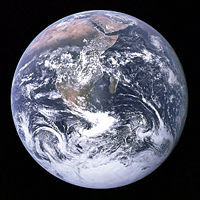Earth (planet): Difference between revisions
imported>Ed Poor (no proof that warmer weather causes such problems - see talk) |
imported>John Stephenson (outside fringe climate-change denial circles, researchers have reached a consensus about global warming (which does not equal "warmer weather"), but here's some references anyway) |
||
| Line 5: | Line 5: | ||
The accepted [[science|scientific]] view is that Earth and every other object in the [[solar system]] descend from a great cloud of interstellar [[gas]] and dust that condensed to form the sun about 4.6 billion [[year]]s ago. Life is known to have found a foothold only on Earth - more than 3.5 billions years ago - however, in recent years, researchers have made advances concerning potential habitats for life on other planets or their [[natural satellite|moon]]s. | The accepted [[science|scientific]] view is that Earth and every other object in the [[solar system]] descend from a great cloud of interstellar [[gas]] and dust that condensed to form the sun about 4.6 billion [[year]]s ago. Life is known to have found a foothold only on Earth - more than 3.5 billions years ago - however, in recent years, researchers have made advances concerning potential habitats for life on other planets or their [[natural satellite|moon]]s. | ||
Earth is home to millions of [[species]], with [[human]]s dominant. Humans have survived and spread through exploiting Earth's resources. | Earth is home to millions of [[species]], with [[human]]s dominant. Humans have survived and spread through exploiting Earth's resources, [[global warming|warming the Earth]] in the process - a fact noted by the vast majority of [[climatology|climate scientists]].<ref>[http://tigger.uic.edu/~pdoran/012009_Doran_final.pdf Doran (2009)].</ref> As a result, [[flooding]], [[drought]] and extreme [[weather]] seem to be more common today than in planet's recent past.<ref>[http://www.ipcc.ch/publications_and_data/ar4/wg2/en/ch19s19-3-6.html Schneider et al. (2007)].</ref> | ||
==Footnotes== | |||
{{reflist|2}} | |||
==See also== | ==See also== | ||
Revision as of 01:58, 24 April 2010

(PD) Image courtesy of: Image Science & Analysis Laboratory, NASA Johnson Space Center
Earth is the only place in the universe known to harbour life. It is the third planet out from its sun. Earth orbits around 93 million miles from the sun, within a region neither too hot nor too cold for its inhabitants to exist. In appearance, it is a blue-and-white little world, settled in a backwater region of the Milky Way galaxy.
The accepted scientific view is that Earth and every other object in the solar system descend from a great cloud of interstellar gas and dust that condensed to form the sun about 4.6 billion years ago. Life is known to have found a foothold only on Earth - more than 3.5 billions years ago - however, in recent years, researchers have made advances concerning potential habitats for life on other planets or their moons.
Earth is home to millions of species, with humans dominant. Humans have survived and spread through exploiting Earth's resources, warming the Earth in the process - a fact noted by the vast majority of climate scientists.[1] As a result, flooding, drought and extreme weather seem to be more common today than in planet's recent past.[2]